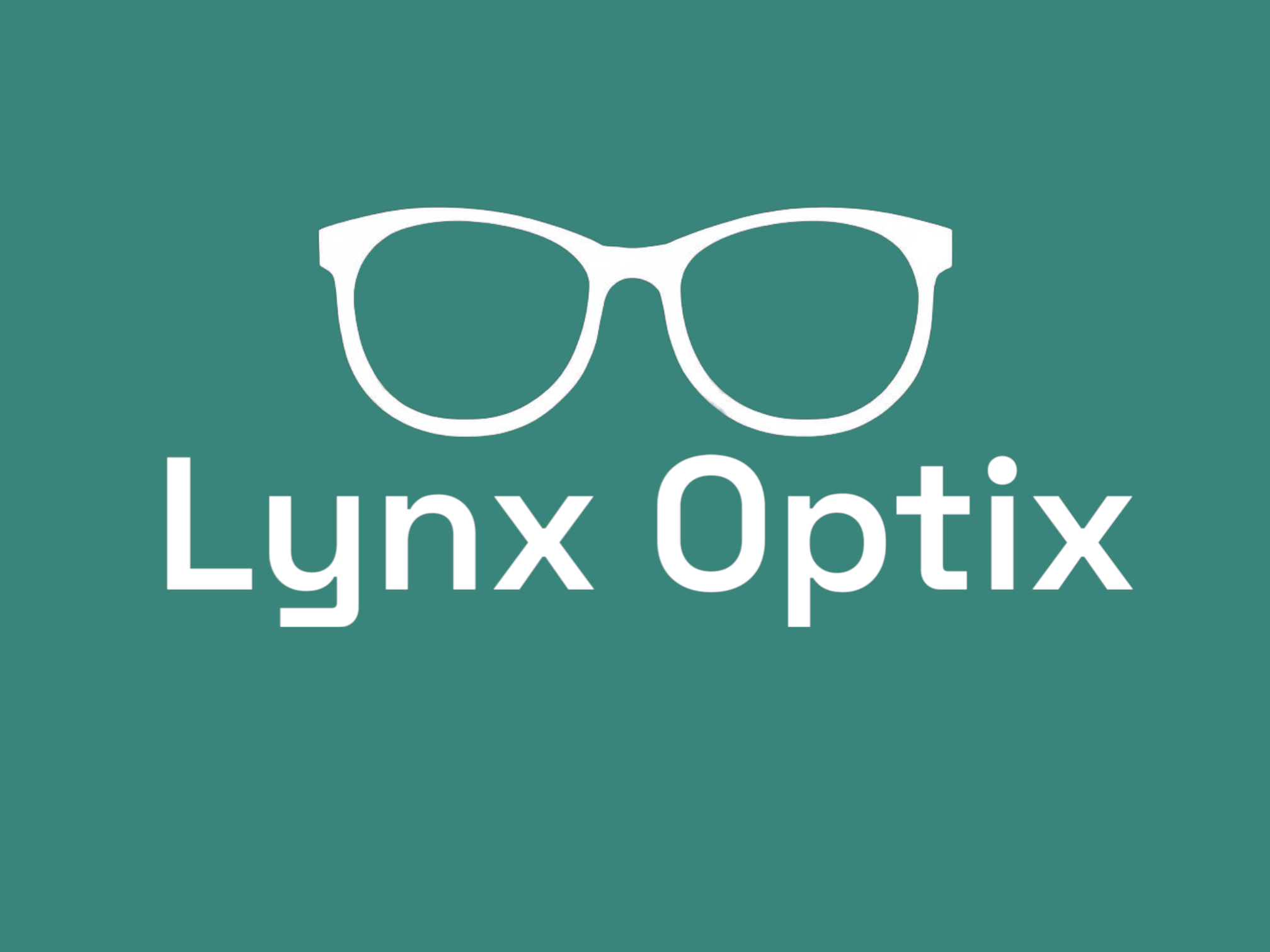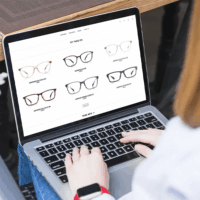
How to order Glasses Online
Ordering prescription glasses online is easy if you follow these steps:
Get a prescription:
Make sure you have a recent prescription from your optometrist
(a valid prescription should not exceed two years).
All prescriptions should include:
• The optometrist’s name, license number and signature.
• Your full name.
• Date of examination.
• Details of your complete visual correction (distance and/or near vision).
Ideally, your prescription should include your PD (pupillary distance) measurement.
If your prescription does not include your PD measurement, you can obtain it from the eye care professionals who
previously made your glasses.This information in your record belongs to you and can be obtained upon request.
Select your frames:
Browse the different frame styles available on our site.
You can filter the options by type, material, size, shape and color to find the one(s) you’re looking for.
* See Good to Know – Frames.
Enter your prescription:
During the ordering process, you must enter your prescription details.
You must also upload your prescription so that the optician can check it.
If necessary, note any comments you feel are relevant for the optician, then validate.
* See Good to know – Prescription.
Choose your lenses:
• Define the use of your glasses.
Ex: Distance , Close-up (reading) or Intermediate (computer)
Multifocal lenses are not sold online at this moment.
• Select the type of lenses you want:
a) Clear lenses
b) Blue light filtering lenses
c) Photochromic & Transition lenses
d) Solar lenses (tinted / mirrored / polarized)
Depending on the type of lenses you choose, we will suggest the lens indexes available for your prescription
(regular & thinned lenses). Make your choice.
* See Good to know – Lenses.
Check your order:
Before finalizing, make sure all information is correct:
• your prescription and PD (pupillary distance)
• your choice of frame(s)
• your lenses and their options: the various available treatments and choice for high-index thinned lenses.
• accessories added to your basket.
• Upload your valid prescription.
• Enter your last name, name and age
Finalize your order:
Enter your shipping address, the shipping method, the payment information and place your order.
Track your order:
Login to your account, select “Order” section and track the status of your order to its final destination ( your beautiful eyes! ).
Receive, try on and enjoy your beautiful glasses:
If you encounter any problems with your new pair(s) of glasses,
Please don’t hesitate to contact customer service.
We’ll be happy to help.
By following these steps, you should be able to order your eyewear online with confidence.
Don’t hesitate to ask customer service for help, if you have any questions during the online purchasing process.
THANK YOU FOR YOUR CONFIDENCE !
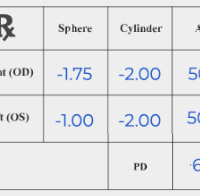
Prescription & Lens Index
PRESCRIPTION & LENSES INDEX ( Index 1.50, 1.56, 1.59, 1.60, and 1.67 )
Reading a prescription for glasses might seem complex, but with a few explanations, you will manage!
Here is how to decipher the essential information from your prescription:
| SPH | CYL | AXIS | ADD | PD | |
|---|---|---|---|---|---|
| OD | -2.00 | -0.50 | 180 | +1.50 | 30 |
| OS | -2.25 | -0.75 | 175 | +1.50 | 30 |
- The numbers under SPH ( sphere ) represent the degree of myopia ( expressed as a negative number )or hyperopia ( expressed as a positive number ). The higher the number, the stronger the optical correction so you will need thinned lenses with an indexof 1.56, 1.59, 1.60, or 1.67.
- The numbers under CYL ( cylinder ) define the value of astigmatism, and the AXIS ( in degrees ) specifiesthe orientation of this astigmatism.
- The numbers under ADD ( addition, expressed as a positive number ) represent the degree of presbyopia.This addition is added to the distance prescription to correct near vision, usually for people aged 40 and over.
- The PD ( pupillary distance ) represents the distance in millimeters between the centers of your pupils.Example: PD: 63. This measure, taken from the center of your nasal bridge, can give different values ( 2 PDs, right and left) e.g., PD 32-31,meaning the distance between your nasal bridge and your right eye is 32 mm, and to your left eye is 31mm. This PD measure is used to align the optical center of each lens with the respective center of your eyes properly,allowing for clearer vision. To order your glasses online, make sure you have a recent prescription from your optometrist(a valid prescription should not exceed two years).
- The name of the optometrist, their license number, and their signature. Your full name.
- The date of the exam.
- The details of your full visual correction (distance vision and/or near vision).Preferably, your prescription should include your PD (pupillary distance) measurement. If it does not include the PD measurement, you can obtain it from the vision professionals who previously made your glasses(This information in your record belongs to you and can be obtained upon request.).
Your prescription should include:
High Index Lenses Explained: Key Differences and Benefits
| LENS INDEX | FEATURES | SPH | CYL |
|---|---|---|---|
| 1.50 | Conventional plastic lenses. For people with light prescriptions. |
-1.50 to +1.50 | 0 to -2.00 |
| 1.56 | Thinner and lighter than the 1.50 Index lenses. For people with moderate prescriptions. |
-1.25 to -4.00 +1.25 to +4.00 |
0 to -2.00 |
| 1.59 | Thinner and lighter than 1.56 index lenses. Impact-resistant Polycarbonate with UV protection. For moderately-strong prescriptions. |
-2.25 to -6.00 +2.25 to +6.00 |
0 to -4.00 |
| 1.60 | Extra thin and light. Great choice for stronger prescriptions. |
-2.25 to -6.00 +2.25 to +6.00 |
0 to -4.00 |
| 1.67 | Extremely thin and light. For extra-strong prescriptions. |
-5.00 to -9.00 +5.00 to +9.00 |
0 to -4.00 |
| 1.74 | As thin as possible for the strongest prescriptions. | +/-7.00 and above | 0 to -4.00 |
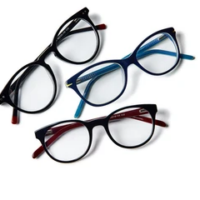
Frames
FRAMES
Our vast selection of frames is meticulously chosen to meet quality, price, and stylish standards.
Frames are made from well-known materials such as acetate, metal, stainless steel, titanium, and TR90 plastic.
All our frames come with a 365-day warranty against manufacturing defects.
Clearance frames do not offer this warranty as they are final sale (most clearance models are discontinued).
Our frames come in different sizes, shapes, and colors. You can filter your search to efficiently find your perfect pair(s).
HOW TO CHOOSE YOUR FRAME:
Several elements come into play when choosing your frame, such as:
THE SIZE:
If you already have a pair of glasses that you find comfortable, you can choose a similar size.
In general, the size is indicated on the inside of the temple.
( e.g., 53x18x140mm: These numbers correspond respectively to the width of the lens, the width of the bridge, and the length of the temples ).
You can also measure the total width of your glasses in mm from one temple to the other near the front of the frame.
Attention: a frame that is too small may make your face appear wider.
ADD DRAWING and size table.
THE SHAPE:
Choosing glasses that suit the shape of your face can really enhance your look and comfort.
Here are some tips for different types of face shapes:
Oval face:
This elongated and rounded face shape allows you to adopt most frame shapes and styles.
It’s the ideal face shape! Have fun choosing your frame. Your possibilities are endless!
Round face:
This face is distinguished mainly by its curves. It would be wise to avoid round frames, as they will only accentuate this shape.
Instead, opt to create contrast by choosing an angular frame shape such as square, geometric, and rectangular.
These shapes help lengthen and slim the face. Cat-Eye glasses will also look good on you, creating a lifted effect.
Square or rectangular face:
This face shape with pronounced angular features is defined by a strong jawline. In this case, it is preferable to avoid angular frame shapes
(square, rectangular, geometric), as these will only accentuate your features. Instead, opt for a frame with rounded contours, such as round,
oval, and cat-eye frames with a rounded bottom.
These shapes can complement and balance the sharp features of this face.
Diamond face: This face is characterized by a narrow forehead and jawline but prominent cheeks and cheekbones.
For this face shape, it is preferable to emphasize the top of the frame to balance your features.
We suggest “browline” frames with a strong browline that contrasts with the cheekbones.
Other frame shapes also work well for diamond faces, such as cat-eye glasses, round, oval, and rectangular glasses.
Heart-shaped face: This face shape is characterized by a wide forehead, high cheekbones, and a narrow chin.
Several frame shapes can balance the broader features at the forehead level, such as browline frames, cat-eye, aviator, round, or oval glasses.
These rounded base shapes provide balance to the narrower, pointy chin.
Triangle face: This face shape is mainly characterized by a wide square jawline and a narrow forehead.
To balance these features, we recommend frames with a wider and more pronounced upper part and a rounded and more discreet lower part.
This created contrast gives the illusion of a wider forehead and a softened, less angular jaw.
For these face features, suitable frame models are aviators, browline, and cat-eye frames.
THE COLOR:
The choice of color for your glasses can vary depending on your skin tone, eye color, hair color, and personal preferences.
Here are some general recommendations:
Warm tone: If you have a warm tone, with golden or olive undertones, the colors of glasses that will enhance you are warm tones such as bronze, copper,
gold, brown, beige, red, orange, and all earthy colors. Avoid: very cold colors like icy blue or steel gray.
Cool tone: For a cool tone with pink or bluish undertones, opt for frame colors such as black, gray, silver, blue, green, or purple.
Brighter tones like electric blue, emerald green, and violet can also be very chic. Avoid: warm colors like yellow or bright red.
Neutral tone: If your tone is neutral with balanced warm and cool nuances, you have more flexibility in color choice. Neutral tones (gray, brown, black)
and bolder colors (red, blue, green) can work very well. Metallic frames (gold, rose gold, silver) can also be elegant choices.
Eye color: You can’t go wrong choosing a frame in the same color as your eyes.
For example, blue glasses would accentuate the beautiful blue of your eyes.
If you have brown eyes, a brown, tortoise, copper, bronze or any other earthy color frame will suit you perfectly.
YOUR STYLE:
The choice of glasses can really reflect and accentuate someone’s personality and style.
Here are some suggestions based on different types of personalities:
Classic and elegant:
Opt for acetate or metal frames in round, oval, rectangular, or aviator shapes.
Neutral colors such as black, brown, gray, gold or silver work well.
These choices are timeless and elegant and complement a traditional and refined style.
Creative and bold:
Choose original or artistic frames in unexpected bright colors. Interesting shapes and unusual patterns can also be a good choice.
If you want to stand out, dare to take risks and express your creativity through your stylish look!
Modern and technological:
Opt for sleek design frames made of modern materials such as titanium, metal, or translucide plastic.
These models with geometric or futuristic shapes complement a contemporary, minimalist, and elegant look.
Romantic and chic:
This selection of frames offers models with delicate details like ornaments, floral patterns, or rounded shapes.
These frames add a soft, feminine, and poetic touch, perfect for someone who loves refined details.
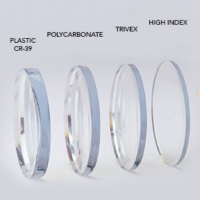
Lenses
LENSES:
All our prescription lenses are prepared for you, according to your prescription and measurements.
They are cut, assembled, and inspected by highly qualified technicians in a Canadian laboratory.
Then, your glasses are carefully checked again by the optician in charge, ensuring a high standard of quality.
All ophthalmic lenses come with a 365-day warranty against any manufacturing defect.
All our clear lenses automatically come with scratch-resistant and anti-reflective coatings at no additional cost.
INFORMATION ON LENSES AND TREATMENTS :
Single vision lenses – distance:
These single vision lenses aim to correct vision problems such as myopia (prescription in -),hyperopia (prescription in +), and astigmatism
(prescription with cylinder and axis).
Single vision lenses – reading (30-40cm):
These single vision lenses aim to correct presbyopia, which is a near vision problem caused by the natural aging of the eye that appears
in the early forties (prescription with addition).
Single vision intermediate/computer lenses:
Single vision lenses correct vision at a distance of about 60-90 cm.
Non-prescription lenses:
If you do not have a prescription but want to make blue light-filtering glasses for screens or stylish sunglasses, you can customize your
glasses according to your needs.
Multifocal lenses:
Multifocal lenses such as bifocal lenses (distance and near vision), progressive lenses (distance, intermediate, and near vision),and degressive
lenses (proximity lenses – near and intermediate vision) correct vision at different distances.
We do not sell multifocal lenses online as they require specific measurements taken with the client by the vision professional.
TREATMENTS:
Scratch-resistant coating:
This is a coating applied to the surface of the lenses, forming a protective layer that makes them more resistant to potential damagecaused by daily handling. Although this coating does not make the lenses “unbreakable,” it significantly improves their durability and maintains
clear vision for longer.
Anti-reflective coating:
This treatment is a coating applied to the surface of the lenses to significantly reduce annoying reflections.This improves contrast as well as visual clarity and helps reduce eye strain, especially during prolonged visual tasks (such as reading, computer work,
or night driving). Additionally, glasses with an anti-reflective coating are more aesthetically pleasing. Their lenses appear more transparent,
making the eyes of the person wearing the glasses more visible.
Blue light protection:
These lenses are treated with a special filter that blocks harmful wavelengths of blue light emitted by computer screens, TVs, phones, tablets, as wellas LED bulbs and fluorescent lamps.
Our blue light protection automatically includes scratch-resistant and anti-reflective coatings.These combined treatments reduce eye strain caused by prolonged screen exposure and improve visual comfort.
For more detailed information, see the Good to Know – Protect My Eyes section.
PHOTOCHROMIC AND TRANSITION LENSES:
Transition lenses or photochromic lenses darken when exposed to UV rays from the sun and become clear again indoors or in the absence of UV light.
These lenses are particularly popular for their convenience and ability to provide continuous protection against UV rays while automatically adjusting
to various lighting conditions.
* For more information, see the Good to Know – Protect My Eyes section.
SUNGLASS LENSES:
All our sunglass lenses come with UV protection. You just need to choose the type of tint and the color that suits you:
- Solid tint in light, medium, or dark intensity.
- Gradient tint.
- Mirrored tint.
- Polarized tint.
Mirrored Tint: Mirrored sunglass lenses protect against sun glare with their mirrored and reflective coating applied to the front surface of the lenses,
also adding style to your sunglasses.
Polarized Tint: Polarized sunglass lenses are designed to reduce glare caused by light reflected off surfaces like water, snow, or roads.
They contain a special filter that blocks intense reflected light, allowing for clearer and more comfortable vision, thus improving color
and contrast perception (reducing eye strain).
For more information, see the Good to Know – Protect My Eyes section.
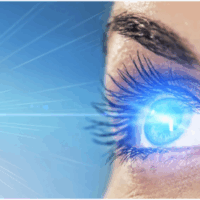
Protect Your Eyes
PROTECT YOUR EYES:
Eyewear plays a crucial role in correcting your vision and protecting your eyes. Whether you wear glasses to correct myopia, hyperopia,
astigmatism, or presbyopia, it is essential to follow certain recommendations to maintain good eye health and protect your eyes from
external aggressions:
1. Protection Against Ultra-Violet Rays:
UV rays are a form of electromagnetic radiation invisible to the naked eye and emitted by the sun. They are necessary in small regular doses
for the synthesis of vitamin D. However, at high doses, these rays become harmful to human health. UV rays cause tanning and can lead to
sunburn, premature skin aging (wrinkles), skin cancers (melanoma), and can even advance the formation of cataracts. To protect ourselves,
we use sunscreen, hats, caps, umbrellas, etc., and for our eyes, we should wear UV protection glasses such as:
- Photochromic / Transition lenses glasses.
- Sunglasses with UV protection. (tinted, mirrored, or polarized)
Prescription glasses with a solar clip-on.
Do not hesitate to wear your sunglasses in all seasons, as UV rays can be harmful throughout the year, even on cloudy days.
2. Protection Against Blue Light:
Blue light is part of the visible light spectrum, with wavelengths between approximately 380 and 500 nanometers. It is present in natural sunlight
as well as in artificial lights emitted by phone, tablet, computer, TV screens, and other electronic devices.
Use glasses with lenses specifically designed to filter blue light, especially if you spend long hours in front of screens. Blue light protection lenses
help reduce eye strain and visual discomfort associated with prolonged screen use. Additionally, this protection provides a noticeable improvement
in sleep quality for most users.
Little Tips:
- Ensure your workspace is well-lit and position your screens at a comfortable distance and angle to avoid annoying reflections and eye strain.
Take regular breaks. We suggest reducing digital eye strain by using the 20/20/20 RULE, every 20 minutes look at something 20 feet (about
6 meters) away for at least 20 seconds.
Keep your eyes hydrated by blinking frequently and, if necessary, use moisturizing eye drops to prevent dryness. (Don’t forget that when we
stare at a screen, we blink less often than usual.)
3. Good Health:
Here are other general recommendations to maintain good eye health:
- Adopt a good balanced diet; consume foods rich in antioxidants, vitamins C and E, such as green vegetables, fruits, nuts, and fatty fish.
- Drink enough water to maintain good hydration, which is also essential for eye health.
- Avoid smoking and limit alcohol consumption, as these habits can increase the risk of eye problems and others.
- Be attentive to symptoms such as blurred vision, eye pain, frequent headaches, and consult a healthcare professional if you experience them.
- For those concerned, monitor the conditions of your chronic disease such as hypertension, diabetes, and others, which can affect your eye health.
4. Complete Eye Exam:
Whether you wear vision correction (glasses or contact lenses) or not, a consultation with an optometrist is important to ensure that your eyes are
healthy and that your glasses prescription is up to date.
A. Vision Exam: Good vision is essential in your daily life. Your optometrist will test your vision by performing a refraction exam to find the best new
prescription. They will also check color vision, depth perception (3D), and eye movement.
B. Eye Health Exam and More: This part of the exam ensures that your eyes are healthy. The optometrist conducts a thorough eye examination and
can detect eye diseases or disorders, such as lazy eye (in children), cataracts, glaucoma, macular degeneration, diabetic retinopathy… In most cases,
the optometrist refers their patient to an ophthalmologist who takes over. Early detection of these eye diseases can prevent or minimize damage.
Eye exams are also important as they can be indicators of your overall health. The optometrist can detect several systemic diseases such as diabetes,
hypertension, cholesterol, certain inflammatory diseases, and some cancers. As they say, “prevention is better than cure!”
Children’s Eye Exam:
It is important to have your children’s vision and eye health examined. Better vision prepares your children to succeed on several levels, such as in their
motor development, learning, and other skills. Here, caution is needed as young children generally do not complain about their vision. They think they see
like others. Therefore, an eye exam would be very valuable at a frequency of once a year throughout their development, up to 18 years old.
In Quebec, the eye exam for those under 18 is covered by the health card. In addition, the provincial government offers a financial assistance program
“See Better to Succeed” offering a reimbursement of $300.00 for the purchase of eyeglasses prescribed by an optometrist for any child under 18 years old.
(*see details at https://www.ramq.gouv.qc.ca/en/citizens/aid-programs/eyeglasses-contact-lenses-children)
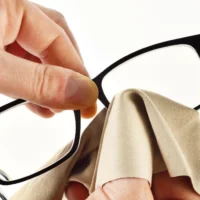
Eyeglasses Care
- Throughout the day, you can clean your glasses multiple times with a microfiber cloth. (This cloth is washable by hand using a mild liquid soap).
At least once a day, we recommend washing your glasses. Don’t forget to wash your hands thoroughly beforehand. Start by cleaning the lenses,
then the entire frame with a glasses cleaning product or wash them with lukewarm water and mild hand soap. To dry them, use a tissue paper.
(Avoid products and solutions containing a high concentration of alcohol, as they may prematurely age your glasses).
If you have access to an ultrasonic cleaner, feel free to use it.
- Glasses not being worn should be stored in their case.
- When placing your glasses on the table, always place them with the folded arms facing up (the lenses facing the ceiling).
Doing otherwise could eventually damage your lenses and their treatments from constant contact with the table surface over time.
- Avoid placing your glasses on your head; the top of the head being wider than the face, the arms will eventually spread, and your glasses will become
misaligned and slide down your nose.
- Always put on and take off your glasses with both hands, and if that’s impossible for you, remove them with one hand by holding the center of the frame.
Removing glasses with one hand leads to the widening of one arm, which malaligns the entire frame.
Your lovely glasses do not like extreme temperatures. The treatments covering your lenses, as well as most frames, are sensitive to high temperatures,
so don’t forget your glasses in the car.

Quebec Programs
EMPLOI-QUÉBEC : For Social Assistance.
The Ministry of Employment and Social Solidarity provides reimbursement for the purchase of prescription glasses to eligible beneficiaries of
the Social Assistance and Social Solidarity program every two years from the date of the last purchase.
Additionally, eye exams are covered by the Régie de l’Assurance Maladie du Québec every 24 months.
Allocated Amounts:
Frame $50
Single Vision Lenses as per prescription $29 – $82
Multi-Focal Lenses based on prescription $58 – $167
Scratch-Resistant Treatment $8 *
*( Only for dependent child )
Reimbursement Procedure:
- Purchase your glasses online.
- Obtain the reimbursement request form for your glasses from your local employment center representative.
- In the “Beneficiary Request” section, check the box for “Moi-même ” (Myself) or “Un membre de ma famille” (Family Member).
- Date and sign the form.
- Send all copies to us by mail at LYNX OPTIX EYEWEAR INC. 170-422 ST Richards Vancouver Brithish Colombia V6B2Z4 Canada.We’ll manage the remaining steps and return the form to your employment center. They will then send you a reimbursement cheque within 1 to 2 months. For more information, visit the following website:https://www.quebec.ca/famille-et-soutien-aux-personnes/aide-sociale-et-solidarite-sociale/prestations-de-base/examen-vue
RÉGIE DE L’ASSURANCE MALADIE DU QUÉBEC : For Children under 18 years old.
The provincial government offers a financial assistance program “Mieux Voir pour Réussir” (“See Better to Succeed”) providing a fixed amount of $300
for the purchase eyeglasses prescribed by an Optometrist for any child under 18, every two years since the last benefit.
Reimbursement Procedure
- Proceed with the purchase of your glasses online.
- You must complete an online reimbursement application, visit the following link:
https://www.ramq.gouv.qc.ca/en/citizens/aid-programs/eyeglasses-contact-lenses-children
Required Information
Child’s health or social insurance number
Applicant’s health or social insurance number
Applicant’s postal code
Type of purchase (glasses or contact lenses)
Total purchase amount
Date of purchase (order date)
Quebec Sales Tax (QST) number of the merchant (10 digits, followed by the letters TQ and 4 digits)
QUEBEC: STUDENT FINANCIAL ASSISTANCE
Students covered by the loans and bursaries program receive financial aid for studies (AFE) covering eye exams as well
as eyeglasses every 24 months.
Reimbursement Procedures
You have two choices:
- Send a copy of your glasses purchase invoice, a copy of your prescription, and the completed government form to the address listed on the form.
Log in to “My Student Financial Assistance File” Follow the instructions, fill out the online form, and attach a copy of your purchase invoice and prescription.
For more information, visit the following
https://www.quebec.ca/en/education/student-financial-assistance/online-services
UNIVERSITY STUDENTS:
By paying your tuition fees, most university students benefit from insurance covering the cost of eyeglasses and eye exams.
